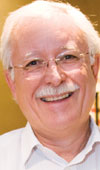
Rob Anderson continues his examination of the analogue to IP procession and finds the success of a project is not about technology, but the manner in which installers approach it.

It was in 2010 that I wrote Part 1 of the journey, using the poem “IF”, by Rudyard Kipling, as a backdrop. (The original article can be found at securitysa.com/4418r. – Ed.). The key question at that time was whether analogue or digital solutions were best. There was a lot of contradictory marketing and the key issues were being lost in the sales pitches.
Has much changed since then? Unfortunately, the answer is no. For those of us who watched the transition from analogue tape recording to digital recording, it was difficult to identify the tipping point. The tipping point being when product maturity and economics make the transition a wise choice.
That is, of course, assuming you are not just an early adopter and you live at what has become known as the bleeding edge, regardless of the costs.
The last 12 months have seen a number of significant changes that continue to play out:
* Improvements in video management software for the IP platform.
* Some sanity intervening in the megapixel arms race. Solutions with ever more pixels are not always necessarily the best choice.
* Thermal cameras coming of age and pricing becoming favourable.
* A number of video analytic products fighting for space in the market. This has contributed to camera and recorder companies undertaking buy-outs to include analytics as part of the offering.
* The analogue providers fighting back and holding a reasonable market share.
* The arrival of Serial Digital Interface (SDI) or HD-SDI as a challenge to the market.
With all the activity and changes, we still see the underlying convergence of the traditional security service provider with the IT industry provider. When the strengths of both industries become a standard, then we will be on a sustainable path to success.
If you are in the business of providing a service in this vibrant industry, be it consulting, supplier, installer or even end-user, it can only be confusing. You have no sooner received the ‘best advice’, when the phone rings to tell you it is wrong and ‘this is the advice you need’. The industry still seems to have this SI unit of measurement called ‘best’. Luckily, everybody sells ‘the best’ product.
To make matters worse, you can wake up in the morning to find that the product you sell has sold out its business to your opposition. And then, when the project is completed, one or both of the following occurs:
* The client says this is not what they expected.
* The system is not operated and managed properly. In fact, the technology has moved past the manager and operator. Their efficiency has fallen and they are not too happy at all.
With one or both of these, the client has doubts or is totally unhappy and so plans the next upgrade with your opposition.
In reality, the same problem exists, in part anyway, in the process control industry. The only major difference is that this industry has been around a lot longer, has a multitude of standards to work to and has gone a long way towards solving the misery with the client at the end. So, how do they do it?
There are a number of reasons for their higher success rate:
1. Proof of concept
In many cases, the proposed solution has either been done before and is just replicated, or the concept is proved to the client as a working solution. The proof of concept phase ensures that the sales team’s dream can also survive reality. In many cases, the proof of concept phase picks up problems that force everybody back to the planning stage. Better to catch these problems early, rather than after the installation is complete.
2. Functional specification
Imagine you have just received a big order and before you start just plugging in product, you sit down and write a proper functional specification. It would add so much value.
The specification must tell the client exactly what they are getting, by typically:
* Defining the installation.
* Providing a job description for each camera.
* Listing all the equipment and defining its purpose.
* Describing the layout of the control room.
* The plan for handling power failure.
* How to make copies of video material for evidence.
* How the system will be operated.
* Defining maintenance requirements.
….. and so on.
And when it is completed, you go through it with your client and obtain formal sign off. This document then goes to your installer, commissioning technician and operational staff which will mean that they will be ready to do it right the first time.
If you can’t write a functional specification, then you will not build your system successfully. If you can’t describe the operation, then you are not a solution provider. Proper design and planning are essential.
The process control industry has been doing this for many years. Complex process plant would never have been successful without this approach.
So, as our vibrant industry works hard to mature and provide good results, it may be time to learn from others who have developed a tried and tested approach that works and start doing proper proof of concept and functional specifications.
It will only be difficult to begin with, then it will become common practice and perhaps even second nature.
Let’s see who will be the first to set the standard for functional specifications for the CCTV industry. It will be a revolutionary change that will see seriously improved outcomes for end users and bring much higher quality to the systems that are installed.
For more information contact Rob Anderson, rob@robanderson.co.za, www.robanderson.co.za

© Technews Publishing (Pty) Ltd. | All Rights Reserved.